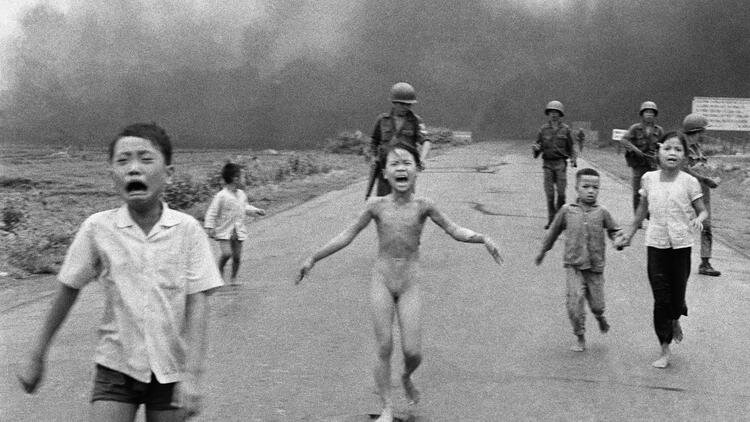
In 1972, Nick Ut captured this photo of Vietnamese children fleeing after an aerial napalm attack. (Nick Ut / Associated Press)
A Norwegian revolt against Facebook’s nude-photo restrictions escalated Friday as the prime minister posted an iconic 1972 image of a naked, screaming girl running from a napalm attack, and the social media network promptly deleted it.
Politicians of all stripes, journalists and regular Norwegians backed Prime Minister Erna Solberg, defiantly sharing the Pulitzer Prize-winning image by Associated Press photographer Nick Ut.
“What they do by removing this kind of image is to edit our common history,” Solberg told the AP in a phone interview.
The image shows screaming children running from a burning Vietnamese village. The little girl in the center of the frame, Kim Phuc, is naked and crying as the napalm melts away layers of her skin.
The protests started last month after Facebook deleted the image from a Norwegian author’s page, saying it violated its rules on nudity.
Many Norwegians posted the photo in protest, and Solberg joined them on Friday, saying social media must distinguish between child pornography and images of historical significance. She said Facebook removed her post as she was on a flight from Oslo to the west coast city of Trondheim.
“Today, pictures are such an important element in making an impression, that if you edit past events or people, you change history and you change reality,” she told the AP, adding it was the first time one of her Facebook posts was deleted.
Solberg later reposted the image with a black box covering the girl from the thighs up. She also posted other iconic photos of historic events, such as a man standing in front of a tank in Beijing’s Tiananmen Square in 1989, with black boxes covering the protagonists.
Facebook, in a statement from its European headquarters in London, responded that “it’s difficult to create a distinction between allowing a photograph of a nude child in one instance and not others.”
Like its Scandinavian neighbors, Norway takes pride in its freedom of speech. It’s also a largely secular nation with relaxed attitudes about nudity.
Several members of the Norwegian government followed Solberg’s lead and posted the photo on their Facebook pages. One of them, Education Minister Torbjorn Roe Isaksen, said it was “an iconic photo, part of our history.”
Many of the posts were deleted but Isaksen’s was still up Friday afternoon. The photo was also left untouched on a number of Facebook accounts, including the AP’s.
It would be physically impossible for the company to comb through the hundreds of millions of photos posted each day so it relies on user reports and algorithms to weed out pictures that go against its terms of service.
Photos are often automatically removed if enough people report them. Facebook usually does not proactively remove photos, with some exceptions, such as child pornography.
Because of this, what photos are and aren’t removed can sometimes be inconsistent, and sometimes leads to Facebook reinstating the photos after removing them.
Norwegian newspaper Aftenposten published the photo on its front page Friday and also wrote an open letter to Facebook founder Mark Zuckerberg in which chief editor Espen Egil Hansen accused the social media giant of abusing its power.
Hansen said he was “upset, disappointed — well, in fact even afraid — of what you are about to do to a mainstay of our democratic society.”
The uproar also spread outside of Norway, with the head of Denmark’s journalism union urging people to share Hansen’s open letter. Germany’s Justice Minister Heiko Maas, who has previously clashed with Facebook over its failure to remove hate speech deemed illegal in Germany, also weighed in, saying “illegal content should vanish from the Internet, not photos that move the whole world.”
Facebook’s statement said it tries to “find the right balance between enabling people to express themselves while maintaining a safe and respectful experience for our global community. Our solutions won’t always be perfect, but we will continue to try to improve our policies and the ways in which we apply them.”
Paul Colford, AP vice president and director of media relations, said: “The Associated Press is proud of Nick Ut’s photo and recognizes its historical impact. In addition, we reserve our rights to this powerful image.”
Before it was published 44 years ago, AP also had a discussion about the image because it violated the news agency’s policy on full-frontal nudity.
Hal Buell, then AP’s executive news photo editor in New York, said he received a message from Saigon photo editor Horst Faas saying a “controversial picture” was coming up.
“Maybe we discussed it on the desk for 10-15 minutes,” said Buell, who is now retired. “But there is nothing about this picture that is prurient. How can we not publish this picture? It captures the horrors of war. It captures the terrible situation of innocents caught in the cross-fire of the war.”
AP published the image and media worldwide used it, though some chose not to, Buell said.





